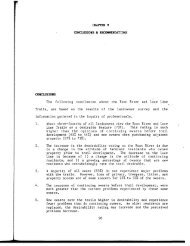Trail Maintenance and Operation - Rails-to-Trails Conservancy
Trail Maintenance and Operation - Rails-to-Trails Conservancy
Trail Maintenance and Operation - Rails-to-Trails Conservancy
You also want an ePaper? Increase the reach of your titles
YUMPU automatically turns print PDFs into web optimized ePapers that Google loves.
Introduction<br />
In about two decades, rail-trails have risen from obscurity <strong>to</strong> become highly<br />
valued amenities for many American communities. Rail-trails preserve natural<br />
<strong>and</strong> cultural resources, <strong>and</strong> provide both residents <strong>and</strong> <strong>to</strong>urists with attractive<br />
places <strong>to</strong> recreate <strong>and</strong> safe routes <strong>to</strong> their destinations. Their well-earned popularity<br />
has led <strong>to</strong> an explosion in the development of rail-trails, with more than 13,000 miles<br />
now in operation in the United States. See Table 1. Some rail-trails have already<br />
overcome legal battles or tedious funding processes. But the biggest challenge could<br />
lie ahead. For 13,000 miles of rail-trails—<strong>and</strong> more than twice that when all the<br />
current development projects come <strong>to</strong> fruition—will now have <strong>to</strong> be maintained in<br />
perpetuity.<br />
Many of the same questions that faced early trail developers now face trail<br />
managers. What needs <strong>to</strong> be done? How do I do it? Who will do it? Who will pay<br />
for it? <strong>Rails</strong>-<strong>to</strong>-<strong>Trail</strong>s <strong>Conservancy</strong> (RTC) recognized the vacuum for this information<br />
nearly a decade ago <strong>and</strong> in 1996 published the first-ever study regarding the<br />
maintenance of rail-trails, “Rail-<strong>Trail</strong> <strong>Maintenance</strong>: Preparing for the Future of Your<br />
<strong>Trail</strong>.” This study has provided valuable information <strong>to</strong> trail managers, planners,<br />
volunteers <strong>and</strong> others as they consider budgetary issues, staffing, equipment <strong>and</strong><br />
various other needs related <strong>to</strong> the long-term maintenance of their rail-trails. Today<br />
the trails community has many more miles under its collective belt, literally <strong>and</strong><br />
figuratively, <strong>and</strong> there is now more information about more trails. Through additional<br />
<strong>and</strong> enhanced data collected for this study in 2004, a more comprehensive<br />
assessment of old, young <strong>and</strong> new trails is now available. And so, we have updated<br />
<strong>and</strong> re-titled our publication,“Rail-<strong>Trail</strong> <strong>Maintenance</strong> <strong>and</strong> <strong>Operation</strong>s: Ensuring the<br />
Future of Your <strong>Trail</strong>—A Survey of 100 Rail-<strong>Trail</strong>s.”<br />
Table 1: Number <strong>and</strong> Miles of Open Rail-<strong>Trail</strong><br />
2 • RAIL-TRAIL MAINTENANCE AND OPERATIONS







